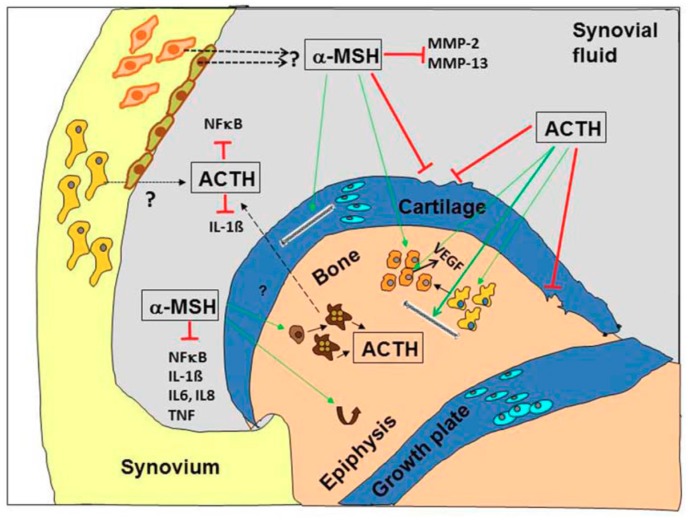Figure 3.
Molecular targets and anti-inflammatory mechanisms of melanocortin peptides in the joint. Proopiomelanocortin (POMC)-derived peptides affect several cellular and molecular targets in the synovium, bone and articular and growth cartilage in the joint. Adrenocorticotropin (ACTH) induces bone matrix production by increasing collagen expression, it induces proliferation of chondroprogenitor cells, it promotes chondrocyte differentiation from progenitor cells, it modulates osteogenic differentiation, and it protects against osteonecrosis by stimulating vascular endothelial growth factor (VEGF) production and it inhibits nuclear factor “kappa light chain enhancer” of activated B cells (NF-κB) pathways and interleukin (IL)-1β expression. α—melanocyte-stimulating hormone (MSH) induces cartilage matrix production (collagen II and aggrecan), it increases proliferation of osteoblasts and stimulates osteoclastic differentiation from precursors, it induces bone turnover of trabecular bone and it inhibits cytokine-induced matrix metalloproteinase (MMP)-2 and MMP-13 expression and IL-1β, IL-6, IL-8, TNF expression and blocks NF-kB pathways. Black arrows indicate origin of POMC peptides within the joint. α-MSH is secreted presumably from CD68-positive synovial cells and endothelial cells and ACTH from CD68-negative synovial fibroblast and presumably from osteoclasts (dotted black lines with question mark). Green arrows indicate stimulatory effects culminating in cell differentiation, proliferation and modulation of gene expression; red bars indicate inhibition and the brown curved arrow indicates bone turnover. Adapted from Böhm and Grässel [12].

